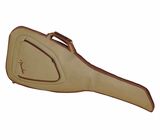While it is not the best in terms of quality (just like with pretty much any textile product, there is an occasional loose thread here and there, but overall, the stitching looks durable), does not offer the best protection (10 mm of padding is more than enough to protect the instrument from scratches and most bumps, but it simply cannot compete with the likes of Mono, let alone a flightcase), and is not the cheapest (there are quite a few pretty decent alternatives at a lower cost), I still consider it a perfect gig bag, and here is why:
1. The protection it provides is more than sufficient for a bedroom guitarist like myself who takes it outside very rarely. As long as I take care not to drop it or lay heavy objects on top of it, the instrument inside will be just fine. This gig bag has not been designed to replace a hard case; therefore, no points should be deducted for its failure to do so. Again, for somebody like me, it is perfect.
2. Yes, the front pocket is not the largest, but it easily fits a 3 meter (or 10 foot) cable, a spare pack of strings, some picks, a couple of tools, and a microfiber cloth, and that is pretty much all that I need. This gig bag has clearly not been designed for globetrotting full-time musicians; therefore, no points should be deducted for its failure to fit what those kinds of players would expect to carry. Looking at the shape of the said front pocket, it is obviously a form-over-function approach. It has obviously been designed to echo the contour of the top of the bag, which, in turn, has been designed to fit the shape of a non-reverse Fender-style headstock — this is obvious. What most people fail to notice, however, is that the aforementioned sloped contour of the top of the bag eliminates the right angle that would have otherwise been there, and it makes the main zipper run smoother and probably even last a bit longer (less likely to deform, snag on the lining, etc.).
3. For those rare instances when I take it outside, the shoulder straps are ergonomically shaped and sufficiently padded. I would even go as far as to say that I find them more comfortable than those on most backpacks I have had throughout my life. Are they the best straps for carrying a heavy guitar a multi-kilometer (or mile) distance? No, but neither were they optimized for that.
Here, I think, is a near-perfect place to make a summary, and the words I would use for it are “perfect balance”: only a large corporation like FMIC could have had a big enough budget and sufficient experience to so expertly fine-tune the parameters of a perfect gig bag, and only a large corporation like FMIC could have had sufficient order volumes to make it as incredible a value for money as it is. Most of the time, the average of everything turns out to be good for absolutely nothing. This gig bag, however, is not a sum of averages. The 600-denier polyester fabric is not average. It is great! In fact, even most backpack manufacturers use significantly lower density fabrics! The zippers are not average either. They run very smoothly and have yet to ever snag for me. Yes, 10 mm of padding might seem quite poor, but the density of the foam matters too. The foam that Fender has chosen for this is one of the firmest I have felt in a gig bag in any price range! I would feel more at ease having my guitar in this than in some gig bags with 15 or even 20 mm of foam. While I have a few minor niggles, I am, overall, delighted with this gig bag. While it does not exceed in any area, it does not disappoint in any area either. As I have said before, it is as perfect a balance as it gets between protection, comfort of carry, quality, price, and esthetics — love it!



